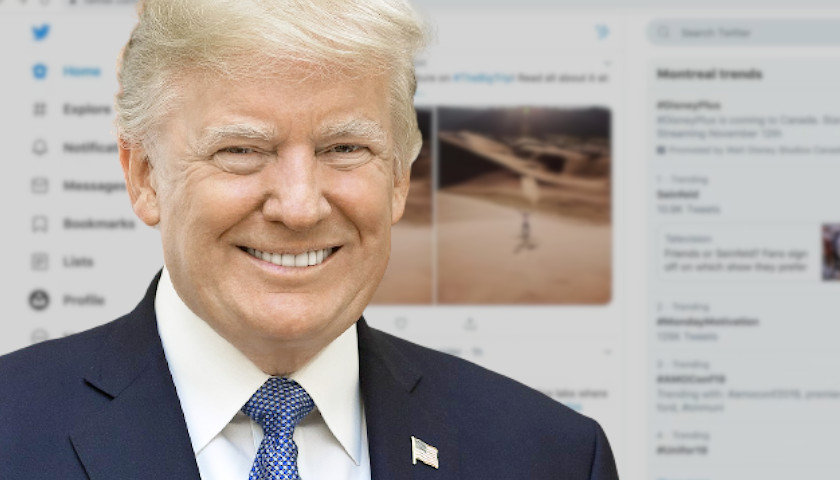by Ben Whedon
The third release of internal Twitter documents on Friday evening detailed the momentous decision to remove former President Donald Trump from the platform after the Jan. 6 riot, making clear that executives understood it was an unprecedented moment in the history of speech.
Alternative journalist Matt Taibbi on Friday released the third set of internal documents as part of an Elon Musk-sanctioned effort to expose the platform’s prior censorship practices.
Twitter permanently banned Trump from using his personal account on Jan. 8. Musk has since restored the former president’s access.
Included in the dump was a screenshot showing an internal message from an unidentified individual asking if Trump was the “first sitting head of state to ever be suspended.”
Taibbi began by promising to detail “the erosion of standards within the company in months before J6, decisions by high-ranking executives to violate their own policies, and more, against the backdrop of ongoing, documented interaction with federal agencies.”
He also detailed that his Friday Tweet series would be the first of three addressing the matter, to be followed by separate document dumps from other journalists on Friday and Saturday.
Taibbi then posted screenshots of communications between Twitter personnel on the decision to ban Trump, highlighting one communication from an unidentified executive asserting that the company needed to consider the “context surrounding” the decision and Trump’s past actions as much as the nature of a specific offending Tweet.
He asserted that the “intellectual framework” for making the decision to ban a sitting head of state fell into place months before the act. Late in the series, Taibbi indicated that “Trump was being ‘visibly filtered’ as late as a week before the election.”
“Before J6, Twitter was a unique mix of automated, rules-based enforcement, and more subjective moderation by senior executives. As [former New York Times editor Bari Weiss] reported, the firm had a vast array of tools for manipulating visibility, most all of which were thrown at Trump (and others) pre-J6,” read the ninth post in the series.
“As the election approached, senior executives – perhaps under pressure from federal agencies, with whom they met more as time progressed – increasingly struggled with rules, and began to speak of ‘vios’ as pretexts to do what they’d likely have done anyway,” Taibbi went on.
He then acknowledged that the Safety Operations department, which had a fairly stringent set of rules for handling disallowed content, clashed with some executives over the matter. He dubbed the more senior executives a “high-speed Supreme Court of moderation, issuing content rulings on the fly, often in minutes and based of guesses, gut calls, even Google searches, even in cases involving the President.”
Included in the post was an exchange between former Head of Trust and Safety Yoel Roth and an unnamed individual over a Trump tweet claiming a “rigged election” after Ohio had to reissue 50,000 incorrect absentee ballots. The exchange shows Roth reply to a query on whether the post violated company policy. Roth replied with an NPR article substantiating Trump’s claims.
The posts then segued into communications outlining regular meetings held between Roth and senior U.S. intelligence officials. One screenshot revealed a communication from a “yoelr,” presumably Roth, lamenting the platform’s inconsistent approach to handling the New York Post’s story based on information from Hunter Biden’s laptop.
“We blocked the NYP story, then we unblocked it (but said the opposite), then said we unblocked it… and now we’re in a messy situation where our policy is in shambles, comms is angry, reporter think we’re idiots, and we’re refactoring an exceedingly complex policy 18 days out from the election,” it read. “In short, FML.” The screenshot further indicated that the message was conveyed as part of a weekly meeting on election security between Roth and the FBI, Department of Homeland Security, and the Office of the Director of National Intelligence.
Taibbi then outlined Twitter’s internal announcement of an “L3 deamplification” tool in December that would tie deamplification to warning labels attached to Tweets.
“The significance is that it shows that Twitter, in 2020 at least, was deploying a vast range of visible and invisible tools to rein in Trump’s engagement, long before J6. The ban will come after other avenues are exhausted,” came the next post.
Taibbi’s Friday post series follows a similar release of internal Twitter documents by former New York Times editor Bari Weiss on Thursday, which focused on the company’s “visibility filtering” practices. Taibbi himself, last week made the first posts in what have become known as the “Twitter files,” detailing the company’s efforts to curtail disfavored viewpoints on the platform.
– – –
Ben Whedon is the night editor for the Just the News. He came to the company from Breitbart News and is a graduate of Washington and Lee University.




